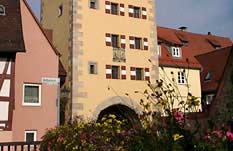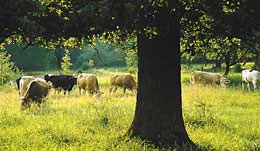|
|
 |
 |
 |
|
 Hersbruck Hersbruck
German "Hirtenmuseum" |
|
The German "Hirtenmuseum”, which is the only museum of that special interest in Germany, documents the various relations between man and grazing animal world-wide.
The museum, which is located in an ancient town house of the 16th century, opened its doors to public in 1933. Since then the picturesque ensemble encloses also the former barn of the house next door, which marks the border of the inner courtyard, and the nearby half-timbered house with its romantic garden within the former town moat.
|
|
 |
|
|
|
 |
|
A private collection about herdsman’s work and donations in kind of many former herdsmen, have been the basis of the museum. Equipment, basic commodities, craftwork and special clothing typical for different regions give a very detailed overview of herdsman’s work all over the world. The exhibition lays emphasis on further subjects: live-stock breeding, animal husbandry and trade in animal products.
|
|
 |
|
|
|
|
|
|
|
Local History of Hersbruck |
|
Around the year 1000 a Bavarian nobleman has built a bridge across the River Pegnitz to complete the ancient trade route between River Main and River Donau (Danube). This bridge probably gave the place its name: Haderihesprucga, the bridge of Haderich.
Already in 1057 Hersbruck received market law, the right to mint coins and customs law. In the year 1297 Hersbruck finally received municipal law.
In 1504 Hersbruck was conquered by the troops of the free city Nuernberg in the War of Bavarian Succession. During the regency of the council of Nuernberg trade and commerce began to flourish in Hersbruck area.
For many centuries Hersbruck was the centre of hop-growing and hop-trade, which increased the prosperity of the city. At that time Hersbruck was also the centre of pasture farming, cattle breeding and herdsman’s culture.
During the National Socialist era a concentration camp was established in Hersbruck (a sub-camp of the concentration camp Flossenbuerg). The prisoners had to work under inhuman conditions to build a top secret underground war plant – the so-called Doggerstollen near Happurg. Over 3000 prisoners died or were killed during the work. |
|
|
|






